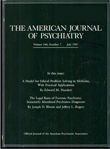Mortality of elderly patients with psychiatric disorders
Abstract
OBJECTIVE: The goal of this study was to evaluate the impact of common late-life mental disorders on the life expectancy and causes of death of older psychiatric patients. METHOD: The study population consisted of 809 older psychiatric patients who met DSM-III-R criteria for organic mental disorders, mood disorders, or psychotic disorders and who were discharged after a comprehensive multidisciplinary evaluation and acute inpatient treatment for their behavioral disorders. Dates and causes of death during a 5.75-year follow-up period were provided by the Pennsylvania Department of Health. Univariate and multivariate survival procedures were used to compare the survival rates of the three groups to each other and to a reference population of Pennsylvania residents. Causes of death were also tabulated according to ICD-9-CM and compared across the groups. RESULTS: Age, gender, race, and medical comorbidity made significant independent contributions to survival. When these variables were controlled, the survival of patients with organic mental disorders was less than half of that for patients with mood or psychotic disorders. However, all three groups experienced higher rates of mortality than the reference population, with standardized mortality ratios of 1.5 to 2.5. Deaths occurred from the usual spectrum of natural causes, with the exception that patients with mood disorders were more likely to have died from disorders of the digestive system and suicide. CONCLUSIONS: The mental disorders of late life have a significant negative impact on the survival of older psychiatric patients.



